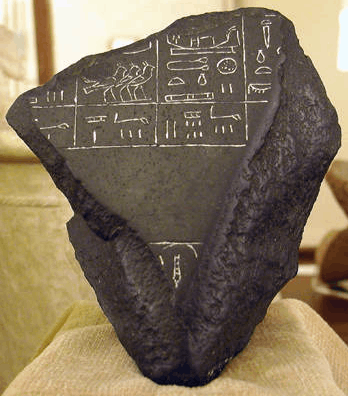Arm, cubit symbol (hieroglyph)
| ||
| Arm (Palm-down) Cubit meḥ in hieroglyphs |
|---|

Nile River flood levels recorded on 1-piece of the 7—piece Palermo Stone.
The Arm, palm down (=Cubit) (hieroglyph), (Arm, with Palm Down (hieroglyph)) is Gardiner's sign listed no. D42 in the series for parts of the human body; a slightly different version with the upper arm slanted, is not the cubit arm, no. D41,
. In the Egyptian hieroglyphic language the "cubic arm" has the phonetic value of mḥ, (meḥ)[1]
|
|
The cubit is approximately 20 inches (from the elbow, to the tip of the fingers).
The cubit arm is used throughout the Palermo Stone of the 24th to 23rd century BC, (the annals and history of the previous ~700 years, ~3200 to 2382 BC). It used in the stone in the recording of the Nile River flood levels, in specific year-register, in "sub-registers" below various King (Pharaoh) entries.
Preceded by
Pyramid mr |
Cubit (Arm) mḥ (meḥ) |
Succeeded by
Whip mḥ |
See also
| Wikimedia Commons has media related to Arm, cubit symbol (hieroglyph). |
- Gardiner's Sign List#D. Parts of the Human Body
References
- ↑ Budge, (1920), 1978. An Egyptian Hieroglyphic Dictionary, p. 316a.
- Budge, (1920), 1978. An Egyptian Hieroglyphic Dictionary, E.A.Wallace Budge, (Dover Publications), c 1978, (c 1920), Dover edition, 1978. (In two volumes, 1314 pp. and cliv-(154) pp.) (softcover, ISBN 0-486-23615-3)